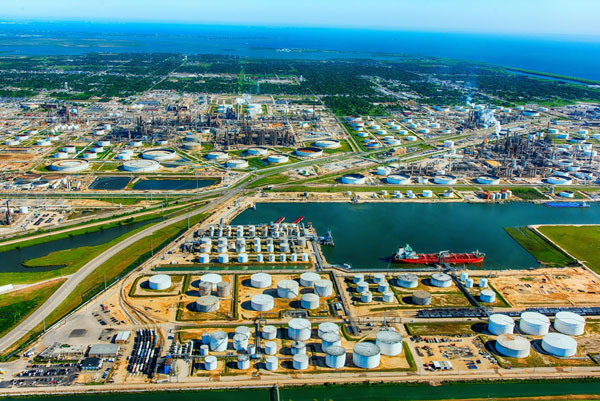When Site Selection looked at the top Texas projects by investment in 2023, it surprised no one that three of the top five projects (representing $33 billion in capital investment) were in the energy sector. The other two are in the closely related chemicals and plastics sectors.
Texas is, after all, the energy capital, from the corporate skyscrapers, campuses and port-adjacent industrial corridor of metro Houston to the fields of West Texas and sites such as bp’s 2,100-employee refinery in Beaumont, which in 2023 celebrated production startup after a $2 billion expansion.
Prominent across the state’s energy profile are multiple liquefied natural gas (LNG) liquefaction complexes playing an equally prominent role in the U.S. economy, even as the White House in January 2024 hit the pause button on further project approvals pending even more environmental review of investments that undergo years of review already. (U.S. Secretary of Energy Jennifer Granholm in March reassured industry executives that the pause was likely to be lifted within a year.)
How valuable is LNG? “By 2030, the U.S. will have a total of 11 LNG export plants in operations,” says the Center for LNG, the Washington, D.C.-based industry association that’s part of the Natural Gas Supply Association. “The combined value of the LNG exported by these plants will reach $100 billion,” the Center says, citing a report from the Energy Policy Research Foundation (EPRF). That’s 3% of the entire U.S. trade balance. Without it, says the briefing, the August 2022 U.S. trade deficit would have been $72 billion, or 7.5% higher.
A February 2024 chart from the EPRF shows that since exports of LNG began from the lower 48 U.S. states in February 2016, the country through October 2023 had exported 353 million metric tons to 49 countries, including a dramatic increase to 50% of European LNG demand beginning in January 2022 after reduction of pipelined natural gas from Russia.
 Linde and bp are developing a carbon capture and storage project to serve the needs of companies along the Texas Gulf Coast industrial corridor near Houston.
Linde and bp are developing a carbon capture and storage project to serve the needs of companies along the Texas Gulf Coast industrial corridor near Houston.
Photo: Getty Images, courtesy of bp
In other words, Texas LNG projects don’t just play a role in the U.S. economy. They join with other Gulf Coast LNG operations to serve the needs of the rest of the world too. Nearly all Texas projects continue to move forward, including the three-train Rio Grande LNG Phase 1 project in Brownsville from NextDecade Corp. The project’s $18.4 billion financing is the largest greenfield energy project financing in U.S. history and its construction represents thousands of jobs.
The company announced its final investment decision (FID) in July 2023 along with signaling to Bechtel Energy it was time to start construction. It also announced on that day the closure of a joint venture agreement for Phase 1 which included approximately $5.9 billion of financial commitments from Global Infrastructure Partners, GIC, Mubadala Investment Company and TotalEnergies. Two more trains are planned, as well as a carbon capture and sequestration facility.
“This project gives TotalEnergies access to competitive LNG thanks to its low production costs,” said Patrick Pouyanné, chairman and CEO of TotalEnergies. “LNG from this first phase will boost TotalEnergies U.S. LNG export capacity to over 15 MTPA [million metric tons per annum] by 2030, and thus our ability to contribute to European gas security, and to provide customers in Asia with an alternative form of energy that is half as emissive as coal.”
NextDecade in March 2024 said it anticipates reaching a positive FID for Train 4 in the second half of 2024.
Another project also unfolding in Brownsville is Texas LNG, a 4-MTPA facility owned and managed by Glenfarne Energy Transition and being delivered by a joint venture between Technip Energies USA and Samsung Engineering Co., Ltd. As the company continues to sign long-term purchase agreements with export customers abroad, it continues to move toward an FID in 2024 with plans to ship out its first LNG cargo in 2028.
Also in March, the Port Arthur LNG Phase 1 project held an official groundbreaking around one year after the positive FID by Sempra Infrastructure. Work is underway for the overall project’s next phase as well as its own carbon sequestration complex. At total build-out, the Sempra project aims to have a capacity of 26 million MTPA, nearly equivalent to the goal of 27 million MTPA at the NextDecade site.
“We each have a part to play to ensure that the transition to a lower-carbon future is well-managed, that affordability and reliability are not sacrificed in the pursuit of sustainability,” said Justin Bird, CEO of Sempra Infrastructure and executive vice president at Sempra. “We can do that by ensuring companies are able to launch timely projects to meet today’s growing energy demand. Port Arthur LNG Phase 1 is uniquely positioned to meet the moment, as it underpins world-class, low-carbon opportunities proximal to the facility, enabling the region to serve as a flagship hub for the energy transition.”
Sempra Infrastructure and Bechtel as of March 2024 had hired more than 1,000 construction and office staff since the FID. Bechtel also has more than 100 local vendors for the project, totaling more than $160 million in local contracts.
Texas Leads the Nation
The Solar Energy Industries Association and Wood Mackenzie in March 2024 announced the U.S. solar industry added a “record-shattering 32.4 gigawatts (GW)” of new electric generating capacity in 2023, a 37% increase from the previous record set in 2021 and a 51% increase from 2022. The top state for solar installations? Texas with 6.5 GW, “eclipsing California for the second time in the last three years,” said the SEIA.
According to the U.S. Department of Energy, as of June 2023, Texas had the most renewable electricity generation in the nation at over 55 gigawatts (GW) of solar, wind and storage capacity, with 42 more GW scheduled to come online in the next three years (including nearly 1.3 GW in the Austin area). Moreoever, the DOE reports having tracked 11 GW of solar module manufacturing investment in Texas since 2020.
The state’s portfolio of renewables and other energy projects continues to grow, including the 187-MW Peacock Solar project from bp and JV partner Lightsource bp located 10 miles north of Corpus Christi in San Patricio County. The portfolio also includes the Noria Hondo project on 2,000 acres of land owned by King Ranch in Kleberg County. That’s where the ranch and Talen Energy will pursue utility-scale development of a 145-MW solar facility and 75-MW battery storage facility.
King Ranch is also the site of the planned South Texas Direct Air Capture (DAC) Hub. To be operated by Occidental company 1PointFive, the hub is expected to include the world’s first DAC plant designed to remove up to 1 million metric tons of CO2 per year.
A carbon capture and storage (CCS) project first announced by bp and Linde in May 2022 continues to move forward along the Texas Gulf Coast industrial corridor in Greater Houston. “The overall development, expected to be operational as early as 2026, will also enable capture and storage of CO2 from other large industrial facilities in the region,” the companies said in 2022, “and could ultimately store up to 15 million metric tons per year across multiple onshore geologic storage sites — the equivalent of taking approximately 3 million cars off the road each year.”

Energy Capital Leads in Energy Efficiency Too
In March 2024 the U.S. Environmental Protection Agency EPA recognized 103 U.S. manufacturing plants that earned the agency’s ENERGY STAR certification in 2023, designated for plants in the top 25% of energy efficiency in their sector. a select club of more than 270 industrial plants that have earned ENERGY STAR stamp since 2006 across 21 manufacturing sectors ranging from cement and steel to glass and commercial bakeries. The top state for 2023 certifications? Texas with 11, including three from Flowers Baking Co.
Texas is No. 2 in the nation in overall ENERGY STAR certifications since the program launched in 1999, with 929, far ahead of No. 3 Florida. And two Texas metro areas make the national top 10 for ENERGY STAR certifications: Austin with 175 projects is tied with Denver at No. 6, just ahead of Houston with 161.

